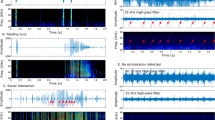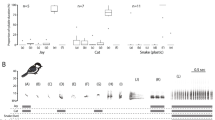This rodent emits a high-frequency shriek as a warning that is inaudible to predators.
Abstract
Apart from echolocation and the pursuit of prey by bats1, the function of ultrasound in animal communication is poorly understood2. This is mainly because of the broad range of responses that it can evoke and the widely varied contexts in which it is used (for example, in rodents of the Muridae family it may indicate distress in infants or a sexual or predatory encounter in adults)3. Here we find that a purely ultrasonic signal is produced in the wild by a rodent of the Sciuridae family, Richardson's ground squirrel, and show that its function is to warn conspecifics of impending danger. To our knowledge, ultrasonic alarm calls have not previously been detected in any animal group, despite their twin advantages of being highly directional and inaudible to key predators.
Similar content being viewed by others
Main
Ground-dwelling squirrels produce audible (8 kHz) alarm vocalizations to warn others of danger. The call recipients benefit from improved detection of predators, and callers benefit through kin selection4. We studied alarm communication among Richardson's ground squirrels (Spermophilus richardsonii; Fig. 1) and noticed that whereas the motor behaviour of some of these animals (10 of 181 individuals exposed to a model predator5) was consistent with alarm calling, they produced only faint sounds of rushing air. These ‘whisper’ calls, which we observed in all our study populations, contain pure ultrasonic frequencies of around 50 kHz (Fig. 2a) and so constitute a previously undescribed vocalization by Richardson's ground squirrels6.
a, Spectrogram (bottom) shows the call duration (238 ms) and dominant frequency (51.6 kHz) of the primary syllable; the signal intensity is represented along the time axis by the density of the grey scale. Inset left, power spectrum showing the intensity of individual frequencies (averaged across the signal). The time–amplitude window (top) shows the overall signal intensity relative to background noise. b, Proportion of time (±s.e.m.) that squirrels (n=19) devoted to vigilant behaviour before (black bars) and during (white bars) the playback of whisper calls and of the three control calls. All experiments complied with the guidelines of the Canadian Council on Animal Care.
We recorded whisper calls from 15 free-living squirrels (for methods, see supplementary information). The mean (±s.e.m.) sound-pressure level of calls was 66.8±2.1 decibels at a mean (±s.e.m.) distance from the squirrel of 0.49 ±0.02 m. The mean (±s.e.m.) duration and dominant frequency of the primary syllable were ±8 ms and 48.0±2.3 kHz, respectively (for details, see supplementary information).
We investigated call function by broadcasting whisper calls and three control calls (these were background noise, a pure tone that matched the whisper call's dominant frequency and an audible call) to recipient free-living squirrels at a site that was 60 km from the recording site. Receiver vigilance was scored (for methods, see supplementary information) and compared among treatments. It was found that the animals spent significantly more of their time on vigilant behaviour in response to the whisper calls and audible control than in response to background noise (Fig. 2b); however, responses to whisper calls were qualitatively different from responses to audible signals. The increased vigilance recorded in response to the pure-tone control (Fig. 2b) was not significantly different from that produced in response to whisper calls.
These results indicate that the function of whisper calls is to warn nearby conspecifics of potential danger and that the dominant ultrasonic frequency is important. Audible calls evoked a more pronounced response than whisper calls, suggesting that whisper calls either convey less urgency than audible calls or that respondents react less conspicuously.
In addition to being inaudible to many rodent predators3, ultrasound (frequency above 15 kHz) differs from audible sound in that it attenuates rapidly and is highly directional7. These apparent limitations as a warning signal may allow callers selectively to warn8 philopatric kin4 while remaining undetected by predators outside the signal's active space.
The attenuation and directional propagation of whisper calls need to be tested to determine whether they enable callers to remain cryptic and whether squirrels selectively beam calls to specific receivers. But selection is likely to favour the deployment of whisper calls under particular circumstances, such as those described here. These vocalizations function as a warning of approaching predators and, given their spectral characteristics, are likely to limit the audience and reduce the probability of detection by the predator.
References
Simmons, J. A., Fenton, M. B. & O'Farrell, M. J. Science 203, 16–21 (1979).
Smith, W. J. Am. Zool. 19, 531–538 (1979).
Sales, G. & Pye, D. Ultrasonic Communication by Animals (Chapman & Hall, London, 1974).
Sherman, P. W. Science 197, 1246–1253 (1977).
Hare, J. F. Anim. Behav. 55, 451–460 (1998).
Koeppl, J. W., Hoffman, R. S. & Nadler, C. F. J. Mamm. 59, 677–696 (1978).
Pye, J. D. & Langbauer, Jr, W. R. in Animal Acoustic Communication (eds Hopp, S. L., Owren, M. J. & Evans, C. S.) 221–250 (Springer, Berlin, 1998).
Witkin, S. R. Condor 79, 490–493 (1977).
Author information
Authors and Affiliations
Corresponding author
Ethics declarations
Competing interests
The authors declare no competing financial interests.
Supplementary information
Supplementary Methods
Complete methods describing the recording and analysis of whisper calls, construction of whisper calls for playback, broadcast of whisper calls to call recipients, and quantification of squirrels’ anti-predator behaviour in response to playback of calls. (DOC 24 kb)
Supplementary Table 1
A complete description of Richardson’s ground squirrel whisper calls, including the sound pressure level (dB), duration (ms), frequency (kHz), and bandwidth (kHz) of the dominant frequency, frequency of additional bands (kHz), and latency and duration of the chuck (ms). Refer to Supplementary Methods for a complete description of these parameters. (DOC 20 kb)
Rights and permissions
About this article
Cite this article
Wilson, D., Hare, J. Ground squirrel uses ultrasonic alarms. Nature 430, 523 (2004). https://doi.org/10.1038/430523a
Published:
Issue Date:
DOI: https://doi.org/10.1038/430523a
This article is cited by
-
The Evolution of Vocal Communication: Inertia and Divergence in Two Closely Related Primates
International Journal of Primatology (2022)
-
Extreme climate event promotes phenological mismatch between sexes in hibernating ground squirrels
Scientific Reports (2021)
-
Hiss and snort call types of wild-living giraffes Giraffa camelopardalis: acoustic structure and context
BMC Research Notes (2018)
-
Altai pika (Ochotona alpina) alarm calls: individual acoustic variation and the phenomenon of call-synchronous ear folding behavior
The Science of Nature (2018)
-
Species-specific and shared features in vocal repertoires of three Eurasian ground squirrels (genus Spermophilus)
Acta Theriologica (2012)
Comments
By submitting a comment you agree to abide by our Terms and Community Guidelines. If you find something abusive or that does not comply with our terms or guidelines please flag it as inappropriate.





